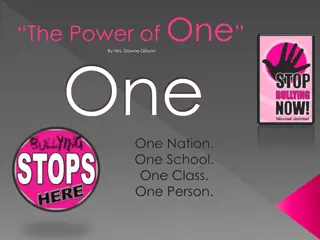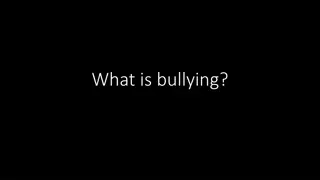Understanding Bullying and its Impact on Special Needs Children
Bullying is an aggressive behavior involving an imbalance of power, often repeated over time. Special needs children are at a higher risk of being bullied, leading to depression, anxiety, and lowered self-esteem. This issue calls for a shift in perception and action to protect these vulnerable individuals.
Download Presentation

Please find below an Image/Link to download the presentation.
The content on the website is provided AS IS for your information and personal use only. It may not be sold, licensed, or shared on other websites without obtaining consent from the author. Download presentation by click this link. If you encounter any issues during the download, it is possible that the publisher has removed the file from their server.
E N D
Presentation Transcript
BULLYING AND THE SPECIAL NEEDS CHILD Edward J. Nitkewicz
How to make sure your child is bullied.. If you want your child to be bullied mercilessly, make sure that his green top hat matches his green tie on Easter Sunday.
What is bullying? Bullying is aggressive behavior that is intentional and that involves an imbalance of power or strength. Typically it is repeated over time. A child who is being bullied has a hard time defending himself or herself. U.S. Department of Health and Human Services
Prevalence of bullying Studies show that between 15-25 % of students are bullied. Half of the victims report that the bullying lasted 6 months or longer. Studies show that 15-20% of students report that they have bullied others Bullying has been identified as a major concern by schools across the country.
More statistics Boys are more likely to bully others Girls are more likely to be targets of rumor and sexual comments Verbal bullying is the most frequent form of bullying Speculation about sexual orientation or behavior is most common form Boys are more likely to be physically bullied
And because our plates are not already piled high enough studies confirm that children with disabilities or special needs are at a higher risk of being bullied than other students.
THE IMPACT OF BULLYING Causes child to be depressed, lonely, anxious and fearful Interferes with student s engagement and learning opportunity Lowers self esteem Suicide
THERE IS AN ANSWER We need to change the way others see, hear and know our children.
Meet the Bully The Good News is that he doesn t look like this The Bad News is that he doesn t look like this He is likely to be someone s beautiful boy or girl
Traits of bully Impulsive Tend to be physically stronger Hot-headed But, smaller children can seek out bigger and weaker children Dominant Easily frustrated Difficulty with rules Angry View violence in a positive way ( eye for an eye )
Family risk factors for bullying Children who bully are more likely to live in homes where there is: Lack of parental warmth and involvement Lack of supervision Lack of behavioral limits and boundaries Harsh physical discipline Model for bullying behavior U.S. Dept. of Health and Human Services
Historical perspective Before IDEA Today Climbing the social ladder included witty put downs of the disabled The Tart Cart The Blueberry The Horticulture Club The Room in the Corner Julie Disability Awareness Resume building community service College applications requiring students to demonstrate social awareness Fraternal approach to the disabled
Okay, what can we REALLY do? Prevention through awareness and education Intervention Support
The Ambassador Program A disability awareness program at South Huntington UFSD History Purpose Impact. Hey, your Mr. Nitkewicz aren t you? Emphasis on demystification of our children and their disabilities Create a bond between the special needs and typical communities
EMPATHY The key to understanding the special needs person The key to overcoming bullying Fostering empathy in our community, our schools, among our fellow parents and our childrens classmates is crucial
Mr. Nitkewicz, I am not for special education. Fear and ignorance George Kunzler De-mystification Familiarize others regarding the unique qualities our children possess
Intervention or helping our children deal with bullying Role playing Immediate generalization Social Stories Video modeling
Communication with your school district Be a firm but reasonable presence Not an easy task, but one that requires more than a kids will be kids approach Be clear that if your child is bullied, you EXPECT a resolution Review your district s anti-bullying policy in the student code The remedy cannot further ostracize your child Let the district propose the resolution
Cyber bullying Our children are highly susceptible to cyber-bullies Easier to bully, to tease, to defame, to torment another when you do not have to look them in the eye You need to know the internet sites and web habits of your children
How to prevent cyber bullying Know your school s cyber bully policies Keep computers in common areas of house Know the relationship between the school and law enforcement Equip computers with Print Screen capacity Look for signs your child is suffering from nightmares, avoiding school, sadness or disinterest Impress that personal information should not be exchanged or posted Know your internet service providers complaint procedure Establish a dialogue with your child regarding computer and internet use and cyber bullying Communicate with your child Know your child s cyber friends and lists
When cyber bullying occurs Use social stories to explain what they are experiencing Encourage your child to confide in you without repercussion Impress upon them the need to reply in only one way: please stop Report the incident to your school district AND your special education director
Suicide prevention Children with special needs are also susceptible to suicidal thoughts Monitor their moods and avoidance behaviors Non-judgmental and open communication in whatever form it takes Key to earning their trust Our children are socially impaired and must feel safe confiding in us
Response of Suffolk County, Inc. Response of Suffolk County is a nationally accredited, community-based suicide prevention agency that provides a free, confidential and anonymous hotline available to anyone who needs suicide counseling. Response s services also include an online crisis counseling program, a community education program, as well as a current computerized information and referral database connecting callers with the most appropriate community resources to meet their needs. Call 24 hours a day. Seven days per week. 631.751.7500
Hear 2 Help online crisis counseling Response offers online crisis counseling for individuals who would rather chat than talk. During after-school hours - Monday thru Friday from 5 pm to 11 pm students can speak with a crisis counselor online. Response counselors are not therapists, but professionally trained and supervised counselors who will talk with callers about any issues of crisis including peer pressure, relationship difficulties, thoughts of suicide, and bullying.
Bullying prevention for the parent of a special needs child Open and respectful dialogue with your child Peer education Providing your child with a method of report and disclosure through discussion or social stories Awareness of mood swings or changes in communication Open and respectful dialogue with the education team Vigilance with regard to your child s use of the Internet Community awareness
Edward J. Nitkewicz Parent, Advocate and Attorney at Law The Sanders Law Firm 100 Herricks Road Mineola, New York 11501 516.741.5252 Enitkewicz@theSandersFirm.com www.TheSandersFirm.com























